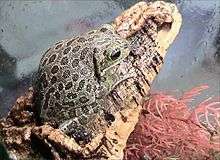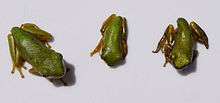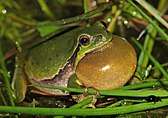Hyla
| Hyla | |
|---|---|
 | |
| European tree frog, Hyla arborea | |
| Scientific classification | |
| Kingdom: | Animalia |
| Phylum: | Chordata |
| Class: | Amphibia |
| Order: | Anura |
| Family: | Hylidae |
| Subfamily: | Hylinae |
| Genus: | Hyla Laurenti, 1768 |
| Species | |
|
See text | |
Hyla is a genus of frogs in the tree frog family Hylidae. They have a very broad distribution; species can be found in Europe, Asia, Africa, and across the Americas. There were more than 300 described species in this genus, but after a major revision of the family Hylidae most of these have been moved to new genera so the genus now only contains 33 species".[1]
The genus was established by Josephus Nicolaus Laurenti in 1768. It was named after Hylas in Greek mythology, the companion of Hercules. The name is unusual in that – though Laurenti knew that Hylas was male – the name is unambiguously treated in the feminine grammatical gender for reasons unknown. The etymology of the name is also often incorrectly given as being derived from the Greek word ὕλη (hūlē, "forest" or "wood").[2][3]
Species


| Binomial name | Common name |
|---|---|
| H. andersonii Baird, 1854 | Pine Barrens tree frog |
| H. annectans (Jerdon, 1870) | Jerdon's tree frog |
| H. arborea (Linnaeus, 1758) | European tree frog |
| H. arboricola Taylor, 1941 | Arboreal tree frog |
| H. arenicolor Cope, 1866 | Canyon tree frog |
| H. avivoca Viosca, 1928 | Bird-voiced tree frog |
| H. bocourti Mocquard, 1899 | Bocourt's tree frog |
| H. chinensis Günther, 1858 | Common Chinese tree frog |
| H. chrysoscelis Cope, 1880 | Cope's gray tree frog |
| H. cinerea (Schneider, 1799) | American green tree frog |
| H. euphorbiacea Günther, 1858 | Southern highland tree frog |
| H. eximia Baird, 1854 | Mountain tree frog |
| H. femoralis Bosc in Daudin, 1800 | Pine woods tree frog |
| H. felixarabica Gvoždík, Moravec, Klütsch & Kotlík,2010 | Arabian tree frog |
| H. graceae Myers & Duellman, 1982 | |
| H. gratiosa LeConte, 1856 | Barking tree frog |
| H. hallowellii Thompson, 1912 | Hallowell's tree frog |
| H. heinzsteinitzi Grach, Plesser, and Werner, 2007 | Mamilla pool tree frog |
| H. immaculata Boettger, 1888 | Spotless tree toad |
| H. intermedia Boulenger, 1882 | Italian tree frog |
| H. japonica Günther, 1859 | Japanese tree frog |
| H. meridionalis Boettger, 1874 | Mediterranean tree frog |
| H. plicata Brocchi, 1877 | Ridged tree frog |
| H. sanchiangensis Pope, 1929 | San Chiang tree frog |
| H. sarda (De Betta, 1853) | Sardinian tree frog |
| H. savignyi Audouin, 1827 | Middle East tree frog |
| H. simplex Boettger, 1901 | Annam tree frog |
| H. squirella Bosc in Daudin, 1800 | Squirrel tree frog |
| H. stepheni Boulenger, 1888 | Northeast China tree toad |
| H. suweonensis Kuramoto, 1980 | Suweon tree frog |
| H. tsinlingensis Liu and Hu in Hu, Zhao, and Liu, 1966 | Shensi tree frog |
| H. versicolor LeConte, 1825 | Gray tree frog |
| H. walkeri Stuart, 1954 | Walker's tree frog |
| H. wrightorum Taylor, 1939 | Wright’s mountain tree frog |
| H. zhaopingensis Tang and Zhang, 1984 | Zhaoping tree frog |
"Hyla" group
Faivovich et al. could not assign these species to a current genus, so they allocated them to the non-taxon "Hyla". Further work is needed to organize them.
| Binomial name | Common name |
|---|---|
| H. alboguttata Boulenger, 1882 | Whitebelly tree frog |
| H. helenae Ruthven, 1919 | Helena's tree frog |
| H. imitator (Barbour and Dunn, 1921) | Mimic tree frog |
| H. inframaculata Boulenger, 1882 | Santarem tree frog |
| H. warreni Duellman and Hoogmoed, 1992 | Warren's tree frog |
Mating Systems
Female Choice Based on Male Calling
The mating systems across most species of Hyla largely feature female choice based on male calling effort [4][5][6]. The specific parameter of calling effort that is selected for can vary from species to species, however. In H. versicolor, for example, females show preference for calls of longer duration[7]. It should be noted, though, that the selection of males which have calls of longer duration has shown to only be advantageous at low densities. This suggests that preference plasticity, based on environmental context, is beneficial[7]. Comparatively, males of H. arborea achieve a higher rate of mating success with increased chorus attendance, that is the number of nights spent calling at a given breeding site[8]. Moreover, increased chorus attendance carries with it a higher energy expenditure and risk of predation. Therefore, it may seem intuitive that males with higher chorus attendance are less likely to survive to the next breeding season. Conversely, these males are more likely to survive. This suggests that the fitness of these males is high enough to overcome the costs associated with chorus attendance[8]. This provides evidence for chorus attendance as an indicator of mate quality in H. arborea.
Male - Male Contests
Although it is studied less frequently than female choice, sexual selection influenced by male-male intrasexual competition does exist in certain species of Hyla. Males of H. versicolor produce conspicuous advertisement calls in large groups at territories known to females[9]. This behavior, known as lekking, is common in many species of Hyla. In order to broadcast a clear acoustic communication to a female, males require distinct calling spaces within their respective leks[9]. When males infringe upon the calling space of one another, aggressive interactions may occur. Males of H. versicolor may choose to lower costs of aggressive encounters by first assessing one another's resource holding potential[10]. In simple terms, the resource holding potential (RHP) of an individual is its ability to win a fight. RHP can be based on a number of factors, including mass, size, weaponry, etc. In H. versicolor, the question of what determines an individual's RHP still stands. Aggressive interactions of this species are hard to observe within natural environments, because they occur briefly and infrequently[9]. Research has suggested that RHP in this species is not based on body size, however these findings were not based on in situ observations, but instead on the findings of a manipulated experiment[10].
Indirect Selection

In terms of sexual selection, indirect selection refers to the selection of a specific trait based on its genetic correlation to overall fitness. H. arborea is a nocturnal species which depends on calling by males for female mate choice[5][7]. In addition to its ability to detect acoustic communications, H. arborea, as well as most other Anuran species, possess specialized visual systems that function particularly well in low light[11]. This visual system allows for detection of observable male traits that could factor into female mate choice. Research has shown that H. arborea females have a preference for males with more conspicuous vocal sac coloration[11]. It is postulated that this preference may assist in localization and detection of males by searching females. However, vocal sac pigmentation is dictated by carotenoid levels, which must be ingested through food intake[11]. Thus, the presence of conspicuous vocal sac coloration could in turn signal higher male foraging ability and fitness[11].
References
- ↑ Faivovich, J.; Haddad, C.F.B.; Garcia, P.C.A.; Frost, D.R.; Campbell, J.A.; Wheeler, W.C., 2005: Systematic Review of the Frog Family Hylidae, with Special Reference to Hylinae: Phylogenetic Analysis and Taxonomic Revision. Bulletin of the American Museum of Natural History, Num. 294, pp.1-240. (http://digitallibrary.amnh.org/dspace/bitstream/2246/462/1/B294.pdf)
- ↑ Charles W. Myers & Richard B. Stothers (2006). "The myth of Hylas revisited: the frog name Hyla and other commentary on Specimen medicum (1768) of J. N. Laurenti, the "father of herpetology"". Archives of Natural History. 33: 241&ndash, 266. doi:10.3366/anh.2006.33.2.241.
- ↑ "hyla". Oxford English Dictionary (3rd ed.). Oxford University Press. September 2005. (Subscription or UK public library membership required.) It gives the 'wood' etymology.
- ↑ Gerhardt, H. Carl; Daniel, Richard E.; Perrill, Stephen A.; Schramm, Susan. "Mating behaviour and male mating success in the green treefrog". Animal Behaviour. 35 (5): 1490–1503. doi:10.1016/s0003-3472(87)80021-0.
- 1 2 Friedl, Thomas W. P.; Klump, Georg M. (2002-01-01). "THE VOCAL BEHAVIOUR OF MALE EUROPEAN TREEFROGS (HYLA ARBOREA): IMPLICATIONS FOR INTER- AND INTRASEXUAL SELECTION". Behaviour. 139 (1): 113–136. doi:10.1163/15685390252902319. ISSN 1568-539X.
- ↑ Gerhardt, H. Carl. "Female mate choice in treefrogs: static and dynamic acoustic criteria". Animal Behaviour. 42 (4): 615–635. doi:10.1016/s0003-3472(05)80245-3.
- 1 2 3 Sullivan, Brian K.; Hinshaw, Steven H. "Female choice and selection on male calling behaviour in the grey treefrog Hyla versicolor". Animal Behaviour. 44 (4): 733–744. doi:10.1016/s0003-3472(05)80299-4.
- 1 2 Friedl, Thomas W.P.; Klump, Georg M. "Sexual selection in the lek-breeding European treefrog: body size, chorus attendance, random mating and good genes". Animal Behaviour. 70 (5): 1141–1154. doi:10.1016/j.anbehav.2005.01.017.
- 1 2 3 Fellers, Gary M. "Aggression, territoriality, and mating behaviour in North American treefrogs". Animal Behaviour. 27: 107–119. doi:10.1016/0003-3472(79)90131-3.
- 1 2 Reichert, M.S.; Gerhardt, H.C. "The role of body size on the outcome, escalation and duration of contests in the grey treefrog, Hyla versicolor". Animal Behaviour. 82 (6): 1357–1366. doi:10.1016/j.anbehav.2011.09.019.
- 1 2 3 4 Gomez, Doris; Richardson, Christina; Lengagne, Thierry; Plenet, Sandrine; Joly, Pierre; Léna, Jean-Paul; Théry, Marc (2009-07-07). "The role of nocturnal vision in mate choice: females prefer conspicuous males in the European tree frog (Hyla arborea)". Proceedings of the Royal Society of London B: Biological Sciences. 276 (1666): 2351–2358. doi:10.1098/rspb.2009.0168. ISSN 0962-8452. PMC 2690462. PMID 19324736.
External links
![]()
![]()
- Frost, Darrel R. 2007. Amphibian Species of the World: an Online Reference. Version 5.1 (10 October 2007). Hyla. Electronic Database accessible at https://web.archive.org/web/20071024033938/http://research.amnh.org/herpetology/amphibia/index.php. American Museum of Natural History, New York, USA. (Accessed: Apr 21, 2008).
- AmphibiaWeb: Information on amphibian biology and conservation. [web application]. 2008. Berkeley, California: Hyla. AmphibiaWeb, available at http://amphibiaweb.org/. (Accessed: Apr 21, 2008).
- eol - Encyclopedia of Life taxon Hyla at http://www.eol.org.
.jpg)